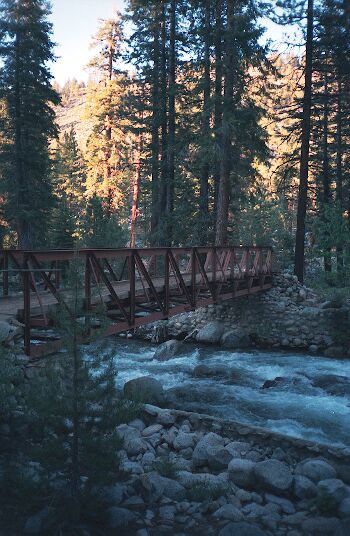
Deadman Canyon Loop

The bridge near the Ranger Station. It is marked wrong on the 7.5 map. This is the gateway to Avalanche Pass and Colby Pass. This bridge has undergone some reinforcement due to floods.
Roaring River
Deadman Canyon Loop - By D.W.Donehoo (All rights reserved)
Hitting the trail again going Southeast, you soon get a good idea of the structure of glacial canyons (and their structure as they meet other canyons) and Deadmans Canyon is a classic. (For a short distance you will see some signs of a old fire.) Your tread seems fairly level for a ways, then you find yourself climbing a steep "step" for a short distance, usually a terminal or recessional moraine, before it once again levels out for a short distance until you get to the next "step", composed of moraine material or more resistant granite.
The spring run-off roars below the bridge. I liked the island with the tree.
These steps don't show up on maps, but they are there and they will get you into a sweat. The topography would suggest the Cloud Canyon glacier dug deeper than the Deadman
Canyon glacier, so therefore left lateral and medial moraine material for the hiker to surmount. The glacial evidence is everywhere: an untidy pile or wall of rocks, glacial erratics (those boulders that seem scattered at random on open expanses of granite), those "steps" and soon, stupendous towering glacially polished vertical walls thousands of feet
high of Yosemite like proportions. If this is your first trip into the backcountry, you will now know what all of the rest of the experienced backpackers know: Yosemite, for all of its admittedly extensive vertical walls, is not unique in the Sierra. Indeed, John Muir often mentioned the many less accessible yosemite's (with a small "y") of the Sierra with their own towering walled canyons every bit as astounding as Yosemite Valley. Deadman Canyon (and Cloud Canyon) is one of those yosemite's Muir referred to and as you toil your way through the entrance to Deadman Canyon, you will have plenty of opportunity to admire the sheer walls beneath Barton Peak and the eastern wall.